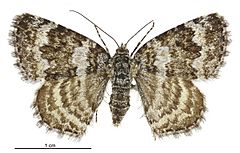Dasyuris octans facts for kids
Quick facts for kids Dasyuris octans |
|
|---|---|
 |
|
| Female | |
 |
|
| Male | |
| Scientific classification | |
| Kingdom: | |
| Phylum: | |
| Class: | |
| Order: | |
| Family: | |
| Tribe: |
Larentiinae
|
| Genus: |
Dasyuris
|
| Species: |
D. octans
|
| Binomial name | |
| Dasyuris octans Hudson, 1923
|
|
The Dasyuris octans is a special kind of moth that belongs to the family called Geometridae. This moth is found only in New Zealand, meaning it is endemic there. Because it's quite rare, the Department of Conservation has listed it as "At Risk, Naturally Uncommon."
Contents
Discovering the Dasyuris octans
This moth was first officially described in 1923 by a scientist named George Hudson. He studied a specimen, which is a preserved example of an animal, that was found by Stewart Lindsay. Lindsay discovered this moth in the Hunter Mountains, near Lake Manapouri, at a high altitude of about 4,000 feet (1,200 meters).
George Hudson later included a detailed description and pictures of the Dasyuris octans in his 1928 book, The Butterflies and Moths of New Zealand. The original specimen, known as the lectotype, is now kept safely at the Museum of New Zealand Te Papa Tongarewa.
What the Dasyuris octans Looks Like
This moth is quite small, with a wingspan of just under 1 inch (about 2.5 centimeters). Its wings are a very light orange-yellow color with black patterns.
On the front wings, the tips are a bit rounded. There's a small white area near the base with black speckles. Beyond this, you'll see two jagged lines that go across the wing. The middle part of the wing has a narrow black band. This band has noticeable narrow spots, especially near the front and back edges. The black lines forming this band are not very clear and have jagged edges. The center of the band is covered with many tiny white flecks. The outer edges of the wings are mostly black, especially towards the tip. There are also many white flecks mixed in with the black, and you might see traces of a wavy whitish line near the edge. The very edge of the wing has a series of black marks. The tiny hairs, called cilia, along the edges of all the wings are cream-colored with black stripes.
The back wings have a dark, slanted patch near their base, also speckled with white. There are two wavy, dark bands across the middle of these wings. The outer part of the back wings has a very wide black band, which is partly crossed by a thin, wavy line.
The head, body, and abdomen of the moth are black, but they are thickly covered with white scales, making them look speckled.
It's easy to confuse the Dasyuris octans with another moth called Dasyuris hectori. However, the D. octans is usually smaller and narrower. It also has a more orange-yellow tint compared to D. hectori.
Where the Dasyuris octans Lives
As mentioned, this moth is found only in New Zealand. Besides the place where it was first discovered, it has been seen in several other locations. These include Homer, the Ruahine Range, and the Kaikoura Ranges. It has also been found at Jack's Pass in Hanmer, Porters Pass, and near Mount Cook. Other sightings have been in Macetown, Vanguard Peak and Advance Peak in Otago, the Kepler Mountains, and Eglinton Valley at Milford Sound.
Moth Life and Habits
The Dasyuris octans is a day-flying moth, which means it is active during the daytime. You can usually see these moths flying around in December.
Home and Food
An entomologist, or insect scientist, named Charles E. Clarke once observed these moths flying over rocks covered in lichen. They were in areas with native grass and other small plants. This suggests that the moths prefer habitats where these types of plants and lichen are common.
Protecting the Dasyuris octans
The Dasyuris octans is currently listed under the New Zealand Threat Classification System as "At Risk, Naturally Uncommon." This means that while the moth is not in immediate danger of disappearing, it is naturally rare. It needs careful attention to make sure its populations stay healthy and don't decline. Conservation efforts help protect its habitat and ensure this unique New Zealand moth continues to thrive.

